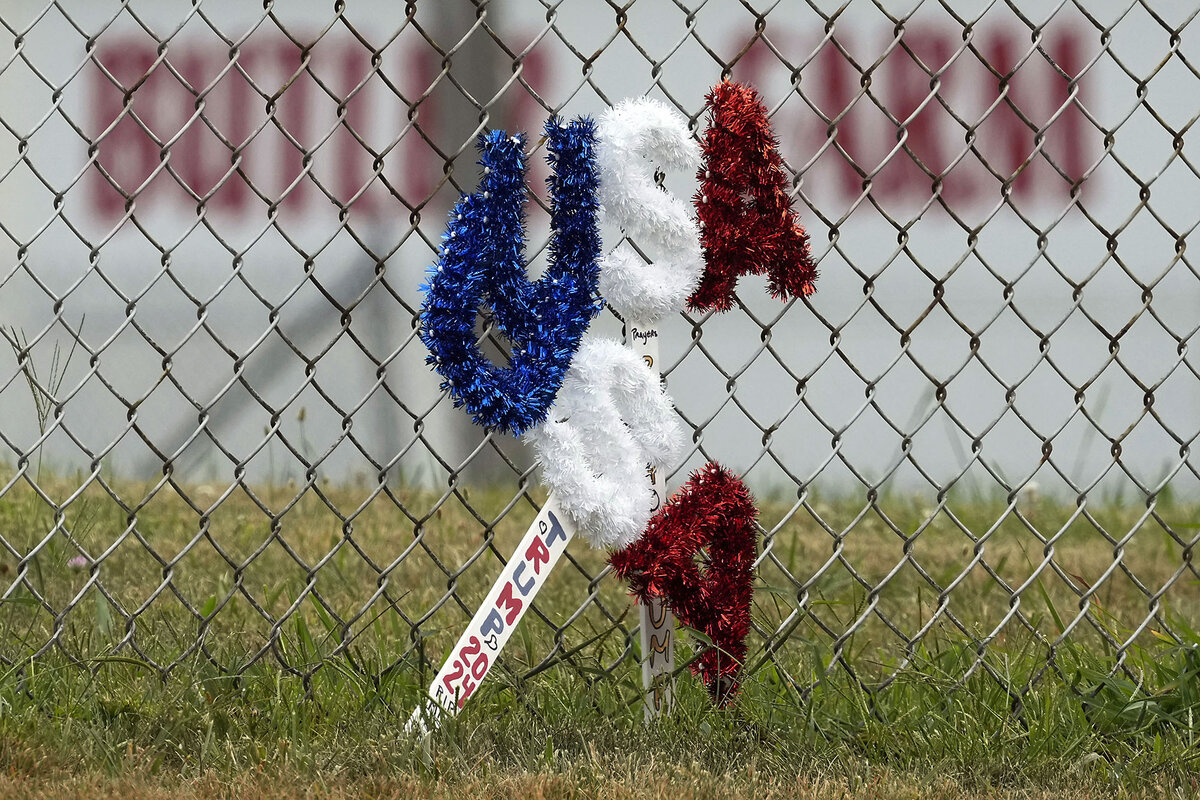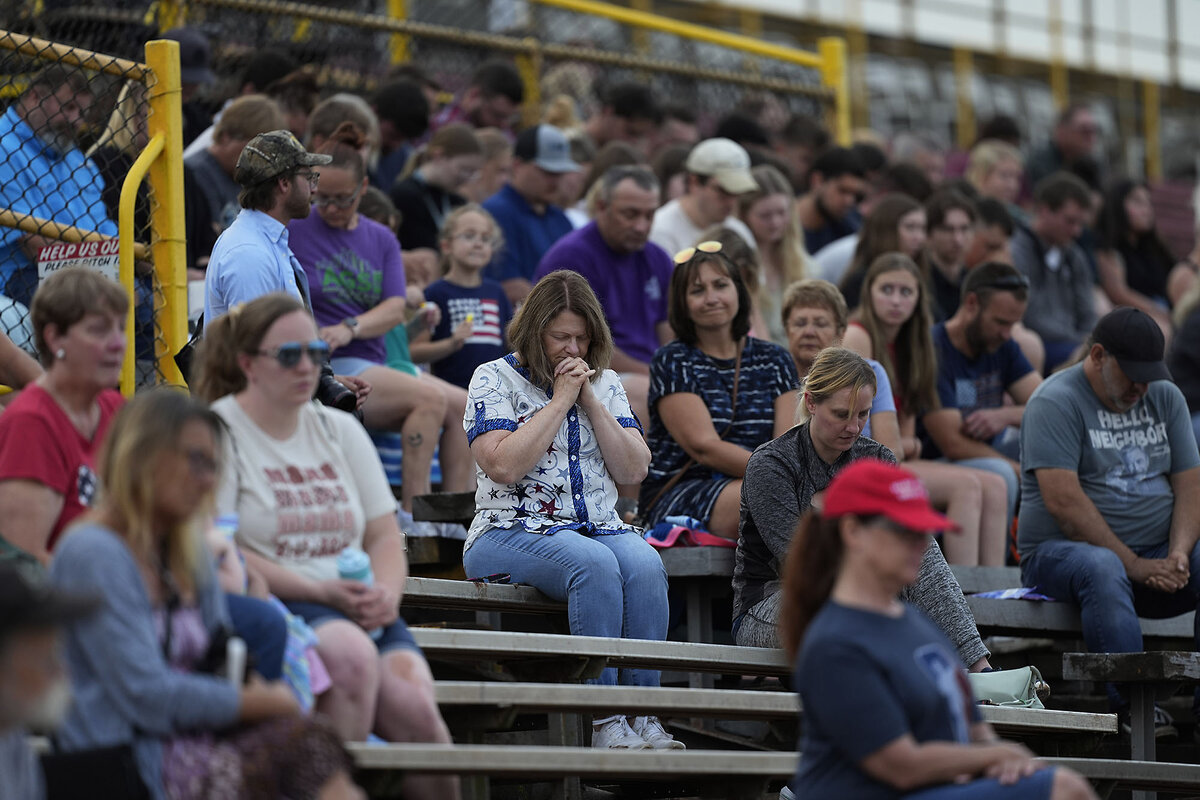In Butler, Pennsylvania, resilience and healing after Trump rally shooting
| BUTLER, Pa.
A week after local retired fire Chief Corey Comperatore died from a shooter’s bullet, Pastor John Neyman built a sermon around a simple idea: Mr. Comperatore’s life and death have new meaning in a nation riven by partisanship.
Mr. Neyman is a spiritual leader in this Trump stronghold north of Pittsburgh, which was shaken earlier this month by an attempted assassination of the former president at a political rally. Mr. Neyman says that stereotypes of the predominantly white, working-class area tend toward “sort of redneck,” reactionary, and socially and economically backward.
Yet as he tends his grieving flock at SonRise Community Church in nearby Sarver, Mr. Comperatore’s hometown, Mr. Neyman has seen a different version of Americans who have long sat at the fulcrum of national politics and whose current hopes and attitudes may shape the upcoming presidential election.
Why We Wrote This
A story focused onViolence can tear apart a community. But in Pennsylvania’s Butler County, many residents are focused on recovery and care for affected families after the near-assassination of former President Donald Trump.
So far, those who live in and around Butler have channeled emotions into grief rather than into anger or fear. And they have lowered the temperature in their conversations, acutely aware of the negative impact of volatile politics on communities.
“People are sad but determined,” says Mr. Neyman. “My job now is to help them forgive what is happening and not give way to anger.”
Support for affected families
This community, while working to heal from the recent shooting, is like countless others across the United States trying to heal in a bigger sense by addressing social and economic stress. Rising threats of political violence nationwide have also put many on edge. Yet Butler and nearby towns are still finding hope and signs of progress.
Mr. Neyman and others here say that while traumatic, this sobering moment has also proved to be a centering one.
In conversations with people in the region since the shooting, University of Pennsylvania political scientist Anne Norton has found their focus is less on the near-assassination of former President Donald Trump and more on Mr. Comperatore and two other rallygoers, David Dutch and James Copenhaver, who were critically wounded July 13.
Butler’s rallying around the Comperatore family symbolizes a focus on “common wisdom,” says Professor Norton. One clue, she says, is that debate around American gun culture has been notably muted despite the shooter’s use of the controversial AR-15-style rifle used in many recent mass shootings.
“There’s a consensus that we’re just not going to have a battle about this, that political violence is bad – that this should never happen again,” she says.
“We’re still standing”
Scott Curcio, an engineer, is staying cool under a tent at the second annual Family and Freedom Festival in adjacent Evans City. Also a woodworker, he sells wooden American flags of his own design and manufacture.
Mr. Curcio’s father worked in the steel mills. He remembers how personally his dad took the layoffs that came as the steel industry globalized in the early 1980s. Yes, they were tough, thankless jobs. But when jobs returned a decade later, his father marched proudly back into the mill.
Today, the plight of such workers is high on the priority list. After new environmental rules threatened 1,300 high-paying jobs at what is now Cleveland-Cliffs Butler Works, workers’ agitation convinced the Biden administration to help fund environmental improvements at the plant so jobs could stay in the area.
“We’re taking haymakers, but we’re still standing,” says Mr. Curcio.
It’s true that former President Trump is popular here, he says, but many voters are less concerned about popularity and personality and more concerned about helping communities. The shooting not only was shocking but also drove home a larger point – hot rhetoric and political violence aren’t solving problems in places like Butler.
“The problem as I see it, and I’m not alone, is that everyone in power is fighting each other, and we’re not getting anywhere,” Mr. Curcio says.
Mr. Trump rallied here shortly before the 2020 election. This summer’s July 13 rally was intended to set the stage for Mr. Trump accepting the Republican nomination in Milwaukee.
“Butler, Westmoreland, Beaver, and similar counties become very key [for the Trump-Vance ticket],” says Matthew Levendusky, author of “Our Common Bonds: Using What Americans Share To Help Bridge the Partisan Divide.” “That’s why Trump did that rally there, and why he’ll do more in similar locales throughout the fall – to try and mobilize voters to turn out for him.”
Butler area’s complex history and identity
A city of 13,000 in a county of about 200,000, Butler is nestled amid steep hills on the banks of Connoquenessing Creek. John F. Kennedy famously stumped in this conservative stronghold in 1960, joking that the local Nixon Lodge would soon be called the Kennedy Inn.
Mr. Trump isn’t the first president to face fire here. As a young man, George Washington came within inches of being felled near here as he trekked through the Allegheny wilderness in 1753, “being shot at by an Indian less than 15 paces from him,” according to a state historical society marker.
A 19th-century oil boom laid the foundation for a bustling downtown as a diverse population settled the city. But by the 1980s, deindustrialization hit the region hard, depressing wages and introducing social scourges like drug addiction.
Although Butler’s median household income of $81,000 is higher than the national average, many here feel the pinch of economic hardship or uncertainty.
A sign outside a local paving firm philosophically sums up the paradox: “One nation, under God. Help wanted.”
University of South Carolina Upstate sociologist Colby King grew up in Butler County and returns every year to visit his parents and friends, always stopping by the famous Burger Hut for a meal. Judging by data and his observations, he says service and caretaker work make up nearly 70% of jobs, compared with 13% of manufacturing-related jobs.
“I think their work caring for and serving their neighbors demonstrates the solidarity and sense of community I saw through my dad and his co-workers a generation ago,” he says.
Professor Norton, similarly, credits the region’s stability partly to the 19th-century Protestant settlers who were deeply anti-imperialist, egalitarian, and progressive.
Those settlers’ values, she says, remain. In one of Pennsylvania’s most conservative counties, local voters gave more support to Vermont’s liberal Sen. Bernie Sanders in the 2016 Democratic primary than to Mr. Trump in the general election, she says.
“These are things that continue to exist that are powerful and ordinary and visceral, but most people don’t connect it to national politics at this moment,” she says. “If you go issue by issue, you get a much more complicated and interesting portrait of American political alignment.”









